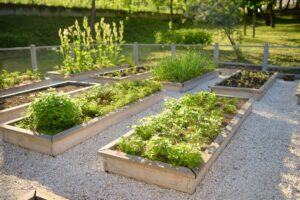Introduction

Permaculture is a holistic approach to land-use planning that takes into account environmental, social, and economic concerns. It originated as an agricultural system based on ecological principles developed by Bill Mollison and David Holmgren in Australia during the 1970s. Since then, it has grown into a worldwide movement of people looking to create sustainable, regenerative systems.
Permaculture is a combination of the words “permanent” and “culture”; it is an integrated system of design that combines traditional farming practices with modern ecological principles. The goal of permaculture is to create self-sustaining ecosystems that are in harmony with nature. This means working with nature, rather than against it, to create an environment that is productive and resilient.
Why Permaculture
When I first began reading about permaculutre the attraction for me was setting up self-sustaining systems. These are the ideas that sold me initially:
- Collecting rainwater off my roof into barrels tht I then used in an automatic watering sytem for my garden and/or my chickens. This would save on my watering bill and my time.
- Having chickens who provide me eggs and help consume my kitchen waste and whoes bedding I can use for my compost pile which can then be used in my garden. Compost is very expensive and you need it every year.
- Using your yard waste such as leaves and grass clippings for compost. Suddenly my yard “waste” was not wasteful at all!
- Employing things like red wigglers to improve my soil, compaion planting and introducing insects who actually attacked my garden pest for me to decrease pest load and allow more of my harvest to survive without chemicals.
- Growing my own red wriggles to make worm casing. They would also eat kitchen scraps. Suddenly nothing was wated! Too if i wanted to go fishing I already had bait!
- How you can take land that is not very fertile and make it more so and build productive food producing systems that make you more self-sufficient and healthy.
This article belongs to pineyriverhomestead.com and was published 9-18-23
That last one was important to me as I had concerns about the fragility of our food deleivery system and the toxicity of the food being deleivered. Mostly though it had a soothing rightness ot how all hte peices fit together and supported an abundant outcome. Primarily though it was the beauty of the possibilty of busilding self-sufficient sytems that all worked togeather to make a better larger whole.

Principles of Permaculture
Care for the Earth
The first principle of permaculture is to care for the earth by understanding the natural cycles and rhythms of the planet. This means being mindful of the way our actions affect ecosystems, preserving biodiversity, and creating systems that can exist in harmony with nature.
Care for People
This principle recognizes that people are a part of the ecosystem and suggests ways to meet their needs while also protecting the environment. This includes creating systems that provide food, shelter, energy, and other resources in an equitable manner so everyone can benefit from them.
Share the Surplus
Permaculture encourages us to share any surplus resources we may have, such as food, tools, or knowledge. This helps create a culture of mutual aid and collaboration that can help sustain communities over the long term.
Use Renewable Resources
Permaculture encourages us to use renewable resources whenever possible. This means using energy from sources like solar, wind, and water instead of relying on non-renewable resources like fossil fuels.
Create Sustainable Systems
The goal of permaculture is to create systems that are self-sustaining and can exist in harmony with nature. This means designing integrated systems that work together to minimize waste, maximize efficiency, and create sustainable, regenerative systems.
Integrate Rather than Segregate
Permaculture encourages us to create integrated systems that draw energy and resources from diverse sources. This means designing systems that make use of natural resources, plants, and animals in ways that are beneficial to the environment and people.
Apply Self-Regulation and Accept Feedback
Permaculture teaches us to listen to feedback from our environment so that we can adjust our practices accordingly. This feedback loop helps us keep our systems in balance and more resilient to change.
Use and Value Diversity
Permaculture encourages us to embrace the diversity of plants, animals, cultures, and ideas in order to create healthy and abundant ecosystems. This means supporting different species and varieties to help build resilience against disease or environmental change.
Design from Patterns to Details
Permaculture encourages us to look at the big picture and understand the patterns that make up our environment before jumping into details. This helps us design systems that are more resilient and sustainable in the long-term.
Use Edges and Value the Marginal
Permaculture teaches us to create edges or “marginal” areas where different elements meet and interact. These edges can be valuable areas for biodiversity and resource management, as well as providing new uses for previously unused resources such as compost or biofuels.
Creatively Use and Respond to Change
Permaculture encourages us to accept change as a natural part of life and use it creatively by anticipating future changes in our environment. This helps us design systems that can withstand the challenges of climate change and other environmental pressures.
I think all these idea’s have great merit. I’m not sure how I interpret them is necessicarily how some would. For my interpretations check out my more detailed post on each principle starting here.
Conclusion
Permaculture is a holistic approach to sustainable living and land management that recognizes the interconnectedness of all life. By using its principles, we can create more resilient systems that benefit both our environment and ourselves.
If you would like to read more check out How to start a Permaculture Garden.
References:
1. Mollison, B., & Slay, D. (1988). Permaculture Two: Practical Design for Town and Country in Permanent Agriculture. Transworld Publishers Limited/UIT Cambridge Ltd.
2. Dyck, J. (2016). Sustainability and permaculture design: A review of principles and applications. Transaction of the ASABE, 59(6), 1741-1754.
3. Schafer Genge, E., & Rilling, J. (2015). Permaculture: Principles and pathways beyond sustainability (2nd ed.). Permanent Publications.
4. Holmgren, D. (2002). Permaculture principles and pathways beyond sustainability. Holmgren Design Services.
5. Whitefield, P. (2004). Permaculture: A Beginner’s Guide to Creating an Edible Garden with Nature in Mind. Permanent Publications.
6. Mollison, B., & Slay, D. (1989). Permaculture One: A Perennial Agriculture for Human Settlements. Tagari Publications.
7. US Department of Agriculture, Nhttps://www.nrcs.usda.gov/wps/portal/nrcs/detail/?ational Resources Conservation Service (USDA, NRCS). (n.d.). Permaculture: A sustainable living system. Retrieved from https://www.nrcs.usda.gov/wps/portal/nrcs/detail/?

